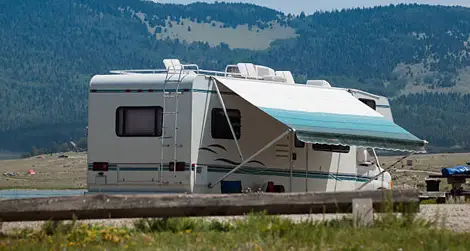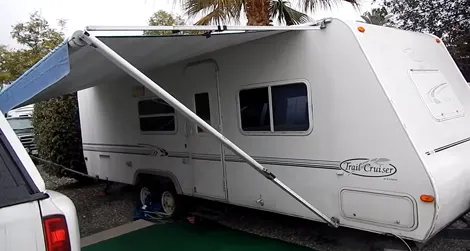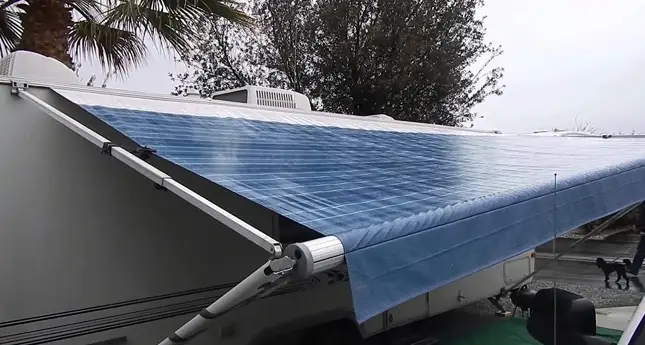Last Updated on April 16, 2023
Maintaining your camper awning is essential if you wish to have a memorable camping experience. But nothing is more unpleasant than being trapped inside the camper during heavy rain. By tilting your awning, you will be able to enjoy the rain without getting wet.
It is possible that the awning can act as a funnel that draws rainwater onto the campsite when it rains. This can be prevented by tilting the awning so the rain runs down the side. That’s why you must know how to tilt camper awning for rain to protect yourself and your belongings.
This can be done by adjusting the support poles or by using ropes or bungee cords to stabilize the awning. To gain a greater understanding of this topic, let’s continue to read this article.
Types of RV Awnings

An RV awning is an excellent accessory to your van, providing protection from the sun and rain while you enjoy the great outdoors. There are a variety of RV retractable awnings available, from manual to automatic (also known as electric power awnings), and each has its unique benefits.
Manual Retractable Awning:
A manual awning is a popular travel trailer awning. It is easy to install and use. The awning can be easily retracted or extended with the help of a hand crank.
This awning is available in different sizes, RV awning fabric colors, and designs to match the specific need of the customer. This type of awning is very popular among campers and travelers as it provides them with an extra layer of protection.
Manual awnings are made up of high-quality materials that make them durable and long-lasting. It is an ideal choice for those who are looking for an affordable and easy-to-install RV awning.
Automatic Retractable Awning (Electric Awning):
Automatic retractable awnings are a fantastic option for those who want the convenience of an awning without the hassle of setting up and takedown. These awnings can be opened and closed with the electric push button, making it easy to get the perfect amount of shade for any occasion.
These electric awnings (like zip Dee awnings) are found in a variety of sizes and colors, so you can find the perfect match for your RV. Plus, they’re designed to withstand high winds, so you’re able to spend time outdoors even when the weather isn’t perfect.
Whether you’re looking for a little extra shade on a hot day or want to create an inviting outdoor space for entertaining, an automatic awning is a great solution.
Another type of awning is the fixed awning, which is attached to the side of the RV and cannot be moved. Fixed awnings are often used to provide additional storage space, as they can be used to store things like bicycles or kayaks.
How to Tilt Camper Awning for Rain : Step by Step Guide

No one likes being caught in a storm while camping, but sometimes they can’t be avoided. If you find yourself caught in a downpour, there are a few things you can do to minimize the damage to your camper. One of these is to tilt the awning.
This will help to keep the water from pooling on top of the awning and causing it to collapse. To tilt the awning follow these steps:
Step 01. Loosen All the Straps:
Loosening all the straps is the first and most important step (for manual awnings) of tilting the awning. If you don’t loosen the straps, water will accumulate within them, eventually causing them to collapse. Once you’ve loosened all the straps, you can begin to tilt the awning.
The amount that you’ll need to tilt will depend on the amount of rainfall. If it’s light rain, you may only need to tilt it slightly. However, if it’s a heavy downpour, you’ll need to tilt it more significantly. Be sure to monitor the weather conditions and make sure that you’re tilting the awning accordingly.
Step 02. Use the Crank to Begin Tilting:
The next step is to use a crank to initiate tilting the awning. This will help you to get the awning started and move in the right direction. You may need to use some force to get the awning moving, but be careful not to overdo it.
Once you have the awning started, you can begin to slowly tilt it until it is at the desired angle. Make sure that you do not tilt the awning too far, or you may end up with water inside your camper.
Step 03. Choose the Right Angle:
The angle of your awning is important for two reasons:
- First, you want the rain to run off the awning rather than pooling on top of it,
- Second, you don’t want the awning to be so steep that the rainwater runs down the walls of your camper.
The best way to find the right angle is to experiment. Start with a shallow angle and then increase the angle until you find a sweet spot that allows the water to run off without pooling.
You may need to make adjustments depending on rainfalls and wind speed. But once you know what angle to use, tilting your awning for rain will be a breeze.
Step 04. Retighten the Straps:
The final step is retightening the straps in tilting your camper awning for rain.
- First, locate the straps on either side of the awning. There should be one near the top and one near the bottom.
- Next, use a wrench or pliers to tighten each strap. Be sure to not over-tighten, as this could damage the awning.
- Finally, check that the awning is secure and there is no danger of it blowing away in strong winds.
By following these simple steps, you can help ensure that your camper awning stays in place during inclement weather. But if you have an electric power awning, there’s no need to worry about tilting it for rain. These awnings have push-button controls that allow you to extend or retract the awning with the touch of a button.
Whether you have a manual or electric awning, be sure to follow these necessary steps to protect your investment. By preparing in advance, you can keep your camper awning in tip-top shape for an extended time.
Material Types for RV Awnings

While there are numerous RV awning options available, they all share one common goal: to provide protection from harsh weather. The most popular types of RV awning are:
01. Acrylic Awnings:
Acrylic awnings are the most common RV awnings that you can find on the market. They’re made from synthetic fabric that is both strong and durable. Acrylic awnings are available in a variety of colors and patterns, so you can find one that perfectly matches your RV’s décor.
02. Vinyl Awnings:
Vinyl awnings are another popular option for RVers. They’re made from heavy-duty vinyl that is designed to withstand the elements. Vinyl RV awning fabric is also UV-resistant, so it won’t fade in the sun.
03. Aluminum Awnings:
Aluminum awnings are lightweight and durable, making them a great choice for those who do a lot of travel. They also offer excellent coverage from the sun and wind. These awnings can be tilted for rain protection, but they should be stowed during high winds.
FAQs
Check out some of the most frequently asked questions regarding RV awnings:
Q: Can You Use a Camper Awning in the Rain?
People believe that it is not safe to put a camper awning out in the rain. But most awnings are made from waterproof materials so they will not sag or leak in the rain. However, it is always best to stow your awning when there is a chance of severe weather.
Q: How Do You Keep an RV Awning From Blowing Away?
RV awnings are a great way to provide shade and protection from the elements, but they can also be susceptible to wind damage. To help prevent your awning from being blown away, you can do these things:
- First, make sure that the awning is properly secured to the RV.
- Second, use sandbags or weighted objects to anchor the awning down.
- Finally, be sure to retract the awning in windy conditions.
Q: When Should I Retract My RV Awning?
The answer depends on the situation. If it’s windy, it’s best to retract your awning to avoid damage. Large patio awnings particularly suffer from strong wind damage because of their size. If it’s raining, you may want to keep the awning tilted to provide shelter.
Q: How Much Wind Can RV Awnings Handle?
While every awning is different, most can withstand winds of up to 20-25 mph (32 to 40 km/h). However, please note that sustained winds can cause significant damage to an awning, even if the wind speed is below 25 mph. If you are expecting high winds, it is best to take precautions and secure your awning.
Conclusion
Your RV can benefit from the addition of an awning, which offers shade and shelter from weather conditions. It is important to take care of your awning, however, to ensure that it lasts for many years. By tilting the awning in rain, you can prevent rain water from pooling onto the camper.
You can use guy lines to secure the awning in place and prevent it from being blown away by strong winds. We hope this guide has helped you better understand how to tilt camper awning for rain in inclement weather.
By following those steps, you can make sure your awning stays in good condition and doesn’t become damaged by the high wind or rain. With a little bit of preparation, you can enjoy your camping trip regardless of the weather.



